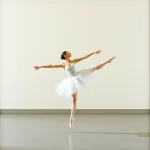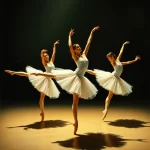Ballet: In the Middle, Somewhat Elevated (William Forsythe, 1987)

Introduction
Ballet: In the Middle, Somewhat Elevated is a groundbreaking contemporary ballet choreographed by William Forsythe in 1987. The ballet features music composed by Thom Willems and was first performed by the Paris Opera Ballet. Known for its abstract and avant-garde style, the ballet does not follow a traditional narrative but instead explores themes of tension, balance, and the physicality of dance.
Historical Background
Creation and Development
William Forsythe created Ballet: In the Middle, Somewhat Elevated during a period of significant transformation in the world of ballet. The 1980s saw a shift towards more experimental and contemporary forms of dance, influenced by social and artistic movements that challenged traditional norms. Forsythe, known for his innovative approach, sought to push the boundaries of classical ballet by incorporating elements of modern dance and abstract expression.
The inspiration behind the ballet was not drawn from a specific literary source or folklore but rather from Forsythe’s desire to explore the physical and spatial dynamics of dance. The collaboration between Forsythe and composer Thom Willems was crucial in developing the ballet’s unique soundscape, which complements its abstract choreography. Other key figures involved in the production included lighting designer Michael Simon and costume designer Stephen Galloway.
Premiere and Reception
Ballet: In the Middle, Somewhat Elevated premiered on May 30, 1987, at the Palais Garnier in Paris. The initial reception was mixed, with some critics praising its innovative approach while others found it challenging to understand. However, the ballet quickly gained recognition for its bold departure from traditional ballet forms and became a staple in the repertoire of contemporary dance companies worldwide.
Notable early performances included revivals by the Frankfurt Ballet, where Forsythe served as artistic director, and later by companies such as the Royal Ballet and the New York City Ballet. These performances helped solidify the ballet’s reputation as a modern classic.
Synopsis of the Ballet
As an abstract one-act ballet, Ballet: In the Middle, Somewhat Elevated does not follow a conventional plot. Instead, it focuses on the interplay between dancers, space, and movement. The ballet is characterized by its high-energy, athletic choreography and the use of minimalist stage design, which emphasizes the dancers’ physicality.
Key moments in the ballet include intricate pas de deux, dynamic group sequences, and solos that showcase the dancers’ technical prowess. The title itself, In the Middle, Somewhat Elevated, refers to the placement of two golden cherries suspended above the stage, symbolizing balance and tension.
Musical Composition
Composer’s Role
Thom Willems, a Dutch composer known for his work in electronic music, played a pivotal role in shaping the auditory landscape of Ballet: In the Middle, Somewhat Elevated. Willems’ score is characterized by its pulsating rhythms, electronic sounds, and minimalist structure, which complement Forsythe’s choreography. The music’s repetitive and driving nature enhances the ballet’s sense of urgency and intensity.
Musical Themes and Motifs
The score features recurring musical themes and motifs that mirror the ballet’s exploration of tension and release. Willems uses electronic beats and synthesized sounds to create a sense of dissonance and harmony, reflecting the dancers’ movements. The music’s abstract quality allows for a wide range of interpretations, adding depth to the ballet’s overall impact.
Famous Recordings and Performances
While there are no widely recognized recordings of the ballet’s music, several performances have been documented and praised for their interpretation of Willems’ score. Notable performances include those by the Paris Opera Ballet and the Frankfurt Ballet, both of which have been lauded for their execution of the challenging choreography and music.
Choreography and Dance
Choreographer’s Vision
William Forsythe’s vision for Ballet: In the Middle, Somewhat Elevated was to create a work that challenged traditional ballet conventions. His choreography is known for its use of off-balance movements, intricate footwork, and dynamic partnering. Forsythe’s innovative approach to space and movement has had a lasting impact on contemporary ballet.
Signature Dance Numbers
The ballet features several signature dance numbers, including:
- Pas de Deux: A duet that showcases the dancers’ technical skill and emotional connection.
- Group Sequences: Dynamic group dances that highlight the interplay between dancers and the use of space.
- Solo Performances: Individual solos that emphasize the dancers’ athleticism and expressiveness.
These key dances reflect the ballet’s themes of tension, balance, and physicality, and are integral to its overall impact.
Notable Interpretations
Over the years, different productions have interpreted Forsythe’s choreography in various ways. Some have emphasized the ballet’s abstract nature, while others have focused on its emotional and physical intensity. Notable interpretations include those by the Royal Ballet and the New York City Ballet, both of which have brought their unique perspectives to the work.
Characters and Roles
Main Characters
As an abstract ballet, Ballet: In the Middle, Somewhat Elevated does not feature traditional characters with defined backgrounds or personalities. Instead, the dancers themselves become the focal point, with their movements and interactions conveying the ballet’s themes.
Supporting Characters
Similarly, there are no supporting characters in the conventional sense. The ensemble of dancers works together to create a cohesive and dynamic performance, with each dancer contributing to the overall impact of the ballet.
Famous Dancers
Several notable dancers have performed in Ballet: In the Middle, Somewhat Elevated, including Sylvie Guillem, Laurent Hilaire, and Darcey Bussell. These dancers have been praised for their technical skill and ability to convey the ballet’s complex themes through their performances.
Cultural and Artistic Impact
Influence on Ballet and Dance
Ballet: In the Middle, Somewhat Elevated has had a significant influence on the world of ballet and contemporary dance. Forsythe’s innovative choreography has inspired other choreographers to explore new forms of movement and expression. The ballet’s emphasis on physicality and abstraction has also contributed to the evolution of contemporary ballet.
Cultural Significance
The ballet’s place in popular culture is marked by its inclusion in the repertoires of major dance companies worldwide. It has been referenced in literature, film, and other media as an example of groundbreaking contemporary dance. The ballet’s abstract nature allows for a wide range of interpretations, making it a versatile and enduring work.
Legacy and Revivals
Ballet: In the Middle, Somewhat Elevated continues to be performed and celebrated today. Major revivals have been staged by companies such as the Paris Opera Ballet, the Royal Ballet, and the New York City Ballet. These revivals have introduced the ballet to new audiences and ensured its place in the canon of contemporary dance.
Iconic Productions
Historic Productions
Some of the most famous historical productions of Ballet: In the Middle, Somewhat Elevated include its premiere by the Paris Opera Ballet and subsequent performances by the Frankfurt Ballet. Key figures involved in these productions include William Forsythe, Thom Willems, and notable dancers such as Sylvie Guillem and Laurent Hilaire.
Contemporary Productions
Recent productions of the ballet have continued to explore its themes and push the boundaries of contemporary dance. Companies such as the Royal Ballet and the New York City Ballet have brought their unique interpretations to the work, incorporating modern elements while staying true to Forsythe’s original vision.
Production Design
The production design of Ballet: In the Middle, Somewhat Elevated is minimalist, with a focus on lighting and costume design. Michael Simon’s lighting design creates a stark and dramatic atmosphere, while Stephen Galloway’s costumes emphasize the dancers’ movements and physicality. The use of two golden cherries suspended above the stage adds a symbolic element to the production.
Critical Reception and Reviews
Initial Critical Response
The initial critical response to Ballet: In the Middle, Somewhat Elevated was mixed. Some critics praised its innovative approach and bold choreography, while others found it challenging to understand. However, the ballet quickly gained recognition for its artistic merit and became a staple in the repertoire of contemporary dance companies.
Modern Reviews
Contemporary critics and audiences continue to appreciate Ballet: In the Middle, Somewhat Elevated for its groundbreaking choreography and abstract themes. The ballet remains relevant today due to its exploration of physicality and tension, and its influence on contemporary dance. Modern reviews often highlight the ballet’s technical demands and emotional intensity.
Fun Facts and Trivia
Behind-the-Scenes Stories
One interesting anecdote from the production of Ballet: In the Middle, Somewhat Elevated involves the creation of the title. The phrase “In the Middle, Somewhat Elevated” was inspired by a conversation between Forsythe and Willems about the placement of the golden cherries above the stage. This title reflects the ballet’s themes of balance and tension.
Notable Performers
Famous dancers who have performed in Ballet: In the Middle, Somewhat Elevated include Sylvie Guillem, Laurent Hilaire, and Darcey Bussell. These dancers have been praised for their technical skill and ability to convey the ballet’s complex themes through their performances.
Trivia
- The ballet’s minimalist stage design emphasizes the dancers’ movements and physicality.
- The use of electronic music by Thom Willems was innovative for its time and added a modern element to the ballet.
- The title “In the Middle, Somewhat Elevated” refers to the placement of two golden cherries suspended above the stage.
Conclusion
Summary of the Ballet’s Importance
Ballet: In the Middle, Somewhat Elevated is significant in the world of dance for its innovative choreography, abstract themes, and emphasis on physicality. William Forsythe’s groundbreaking work has had a lasting impact on contemporary ballet and continues to inspire choreographers and dancers today.
Final Thoughts
Reflecting on Ballet: In the Middle, Somewhat Elevated, it is clear that Forsythe’s vision and Willems’ music have created a timeless work that challenges traditional ballet conventions. The ballet’s exploration of tension, balance, and movement makes it a compelling and enduring piece. For those interested in contemporary dance, watching a performance or listening to the score is highly recommended.
FAQ
What is the central theme of this ballet?
The central theme of Ballet: In the Middle, Somewhat Elevated is the exploration of tension, balance, and the physicality of dance.
Who are the main characters in this ballet?
As an abstract ballet, there are no traditional main characters. The dancers themselves become the focal point, with their movements conveying the ballet’s themes.
What is the most famous dance number in this ballet?
One of the most famous dance numbers is the intricate pas de deux, which showcases the dancers’ technical skill and emotional connection.
How long does a typical performance of this ballet last?
A typical performance of Ballet: In the Middle, Somewhat Elevated lasts approximately 30 minutes.
Are there any modern adaptations of this ballet?
While there are no direct modern adaptations, the ballet continues to be performed by contemporary dance companies worldwide, often incorporating modern elements while staying true to Forsythe’s original vision.
Why is this ballet considered important in the history of dance?
Ballet: In the Middle, Somewhat Elevated is considered important for its innovative choreography, abstract themes, and influence on contemporary ballet. William Forsythe’s work has had a lasting impact on the evolution of dance and continues to inspire choreographers and dancers today.





